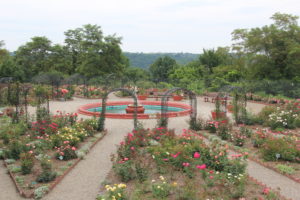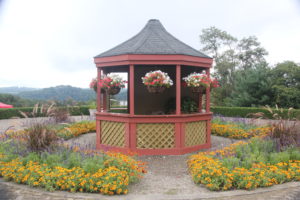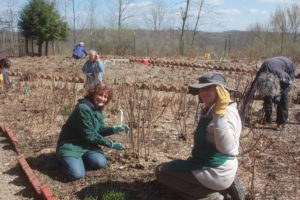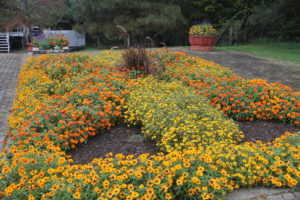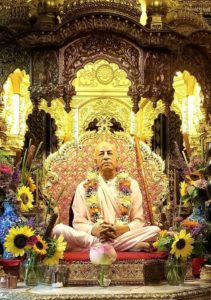Prabhupada’s Palace Gardens Enter Sustainable New Chapter
By Madhava Smullen for ISKCON New Vrindaban Communications
The gardens at Srila Prabhupada’s Palace have always been jewels that enhance the beauty of this place of pilgrimage; while themselves becoming more beautiful by serving the pure devotee.
In 2014, after a long and illustrious history, they began their transition from chemical to organic. And today, like much of New Vrindaban, there are efforts to make them more practical and sustainable so that they can continue to flourish in Prabhupada’s service long into the future.
In September 1979, when the Palace first opened, the idea was to make the gardens as elaborate as possible to reflect its opulence. Beds were laid out formally on the Palace’s multi-level terraces and patios with cast concrete borders, fountains and symmetrical designs.
Vidya Dasi was the first head gardener, starting in 1980 and transporting flowers and other plants from the greenhouse at Bahulaban. The next year, miniature roses were planted around the Palace itself, beginning the famous Rose Garden. On the second level down, dahlia gardens appeared in front of the lotus-shaped fountains. On the ground level, in the Garden of Time, a colorful mix of annuals were planted. And just inside the entrance of the property, Vidya planted two 400-foot beds, and decorated the walkways with basket planters full of geraniums and petunias.
By 1984, Vidya and her crew were tending to 30,000 annual flowers, 40,000 spring flowering bulbs, and 5,000 tender summer flowering plants. Flowering shrubs and evergreen trees such as white pines and Norway spruce were positioned on the front slope of the Palace, as well as many rhododendrons. Lotus flowers and lilies grew in the fountains. And with the success of a 300+ plant rose garden, devotees decided to eventually plant the entire Garden of Time with roses.
“A lot of people ask me for my garden secrets,” Vidya wrote in a Brijabasi Spirit article during the 1980s. “This is my best one. Love is service; service is love. You can’t separate them. In growing flowers for Krishna, we’re showing Him our love. It’s practical.”
After Vidya, Betty Hickey, who came from a neighboring family of farmers, became the Palace Gardens caretaker in 1985 and managed them for the next twenty-six years.
Under Betty, in 1987 the Palace Rose Garden became one of only 130 gardens in America accredited by the All-America Rose Selections (AARS), which held very high standards.
This non-profit organization ran the world’s most challenging horticultural testing program, and gave the most exceptional roses its seal of approval. It would then give five of these winning rose varieties free of charge to AARS-accredited gardens like the Palace Rose Garden every year to showcase.
At one point, the Palace Garden boasted over 100 different varieties of roses, while close to half of its 850 rose plants were AARS winners.
In addition, the AARS awarded the Rose Garden certificates of achievement for garden maintenance nine times between 1992 and 2007.
As a result, the Garden frequently made newspaper headlines and drew tourists and rose afficianados from around the country in their thousands. Serving as the tour guide, Betty would lead them around, charming them with her warmth and botanical knowledge.
In 2011, Betty retired. New Vrindaban residents praised her for her care, dedication and kind-heartedness. For her part, Betty said she had “made so many wonderful friendships over the years” and commented, “I think that it’s not work if it’s good work, and I always enjoyed my work here.”
At Betty’s request, Gopalasyapriya Dasi stepped in to oversee the Gardens, a service that means a lot to her. Gopa grew up in the suburbs of Detroit – but working in a greenhouse as a teenager turned her towards spirituality.
“It changed my life,” she says. “I had never thought much about God, but watching the plants grow and seeing their variegatedness and tiny intricate root systems made me start appreciating the Lord’s creation.”
Gopa started working with Betty back in 2000, learning everything she could from her. So she was a perfect replacement. Starting in 2014, Gopa began implementing ISKCON New Vrindaban’s decision to shift from chemical care to a more sustainable and organic garden.
The move was made based on research showing that while pesticides and products like Round-Up control weeds and bugs, they also have many negative effects. Organic methods, devotees decided, are far better for health, the environment and of course for smelling and offering to Krishna.
Aiding devotees in the change was expert rosarian Paul Zimmerman. Paul was adamant that despite common misperceptions, roses do not need lots of chemicals to be healthy and flourish. He said it would take them several years, however, to adjust to the change and build up their immune systems naturally.
Some of the techniques included improving the quality of the soil with organic fertilizers, mulch and compost; spraying with vinegar; removing weaker varieties of roses and replacing them with naturally bug-resident strands; and putting in companion plants such as Dahlias and Blue Salvias.
As of now, the Rose Garden is gradually beginning to adjust and flourish with a more natural beauty, and is expected to really come into its own with the next couple of years. The new approach is sure to appeal to today’s more health and environment-conscious public. It’s also in line with Vaishnava principles and Prabhupada’s simple living vision for New Vrindaban.
These days, Gopalasyapriya continues to work with the roses while Mukunda Dasi is the head gardener. And under her and Prabhupada’s Palace manager Vrajakishor Das, there is another shift afoot: devotees are working to increase the overall beauty of the gardens, while simplifying the presentation so that they are easier to maintain in the long run.
The Rose Garden still grows mostly roses and is a gorgeous sight when in full bloom. Tear-shaped beds arranged in a semi-circle around the fountain are full of dozens of varieties in orange, yellow, pink, white, red, and purple. They’re peppered with delights like miniature roses, a “hot chocolate” rose and a tall red one called “Mr. Lincoln.” Between each bed are wrought-iron trellises welded by devotees and decorated with beautiful climbing roses.
But now, with a focus on simplification and with the All-American Rose Society no longer in existence, there are also other kinds of flowers in the rose garden: tulips, rhododendron and azalea bushes, vinca, dahlias and zinnias, all of which make it burst with color.
“In the outer walkways and gardens surrounding the Palace, we’re also starting to introduce some perennials, so we don’t have to keep planting ever year,” says Vrajakishor. “We’re simplifying the varieties, and doing more standardized color schemes. Around the exterior edge of the Palace wall, we’ve replaced what used to be a plantable garden bed with decorative stone. This highlights the architecture of the Palace more and saves a lot of labor just for that one bed!”
It’s a strategy that’s sure to keep Srila Prabhupada’s Palace Gardens attracting thousands long into the future. And Mukunda and Gopalasyapriya are delighted to work together on it.
“We started in the Gardens about fourteen years ago under Betty Hickey,” says Mukunda. “I just love Gopa – she’s a wonderful personality, one of my favorite people in New Vrindaban.”
Gopa says the same. And both add that they love serving in the Gardens, because it keeps them grounded and connected to Srila Prabhupada and Krishna.
What’s more, Gopa feels that when the Gardens are well-maintained, they add to guests’ appreciation of Prabhupada’s Palace. They also create a spiritual world-like atmosphere and reflect well on the community.
“When they are well cared for, it shows that there’s love and devotion — bhakti – going on here,” she says with a smile.
